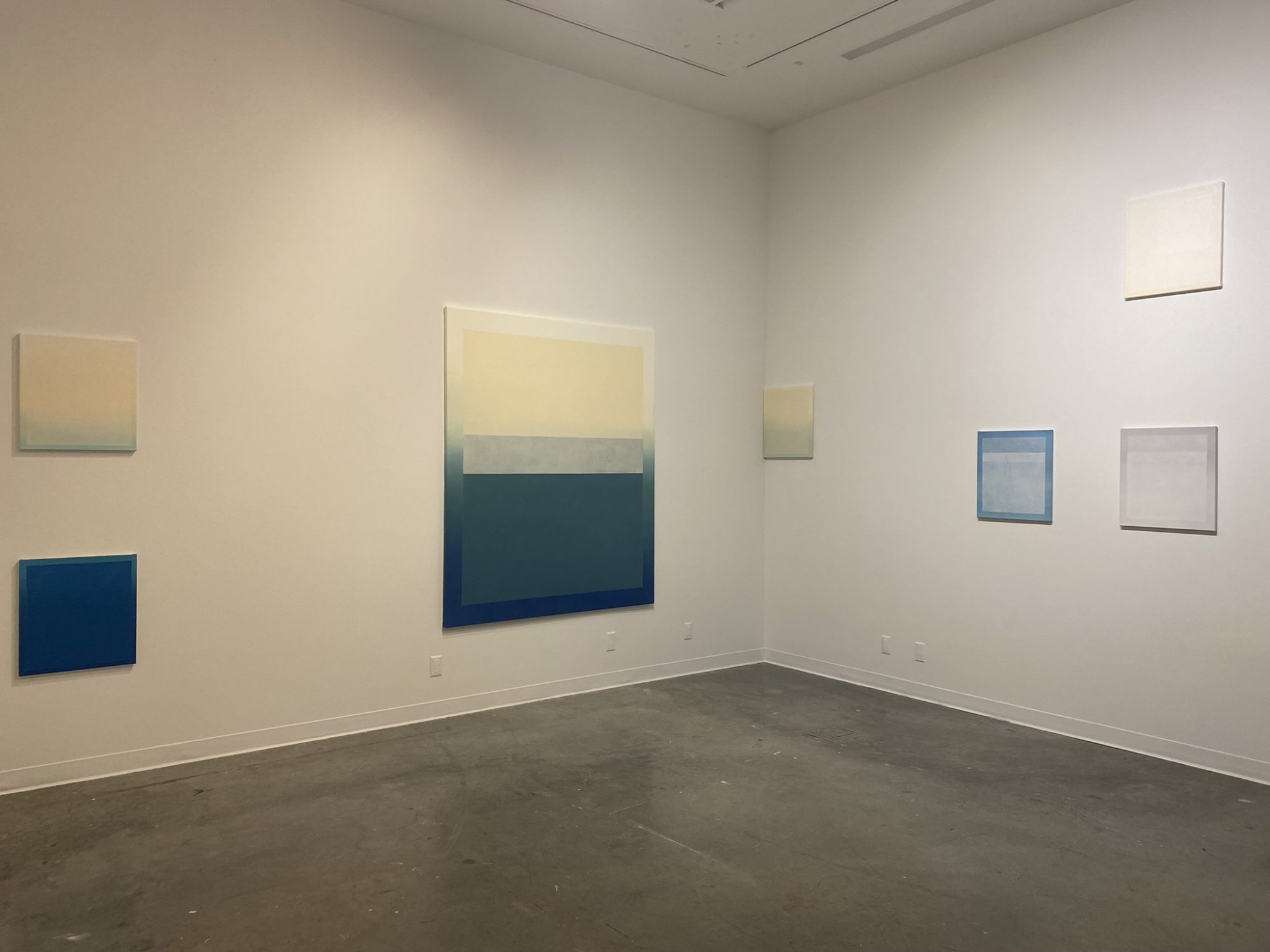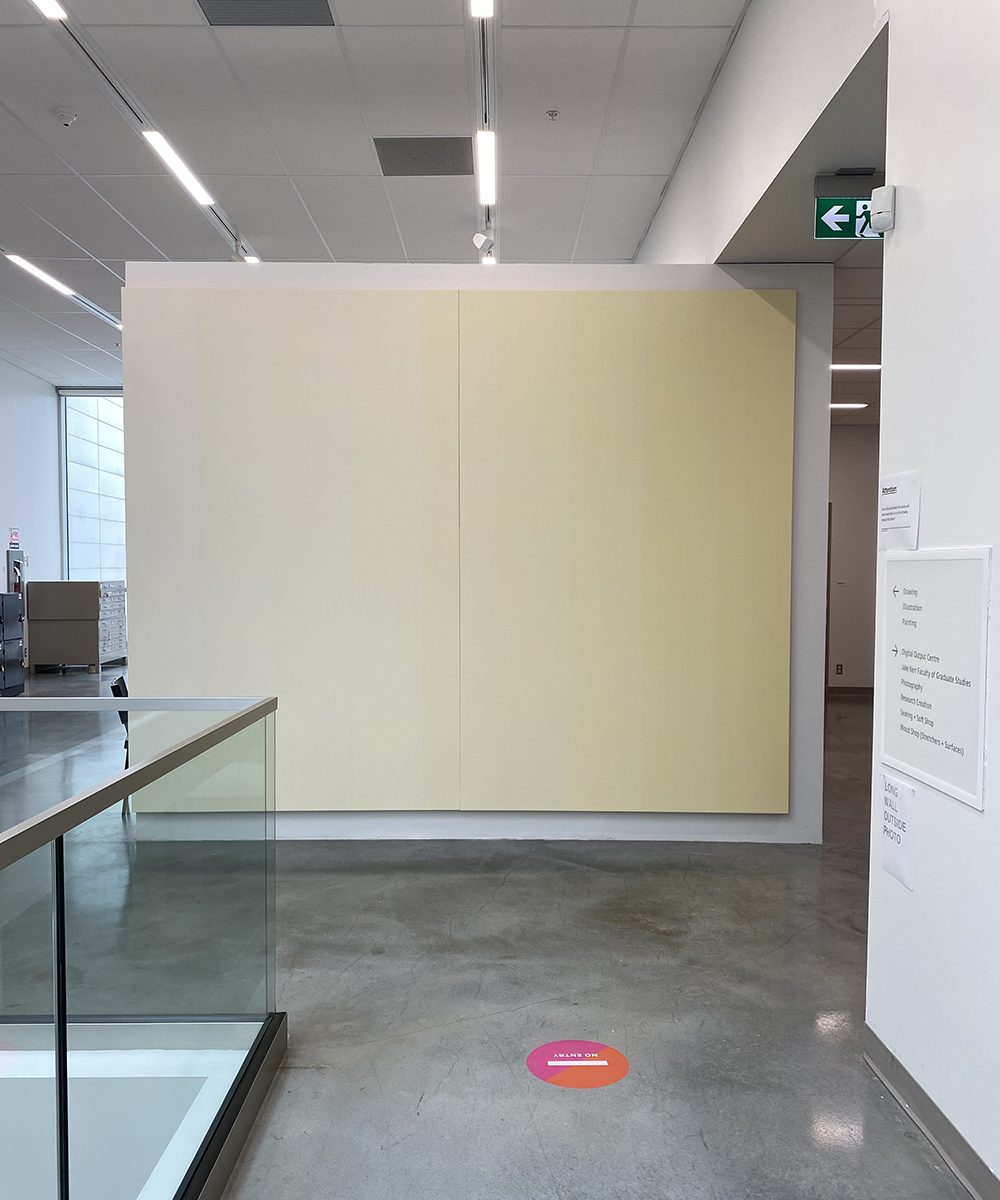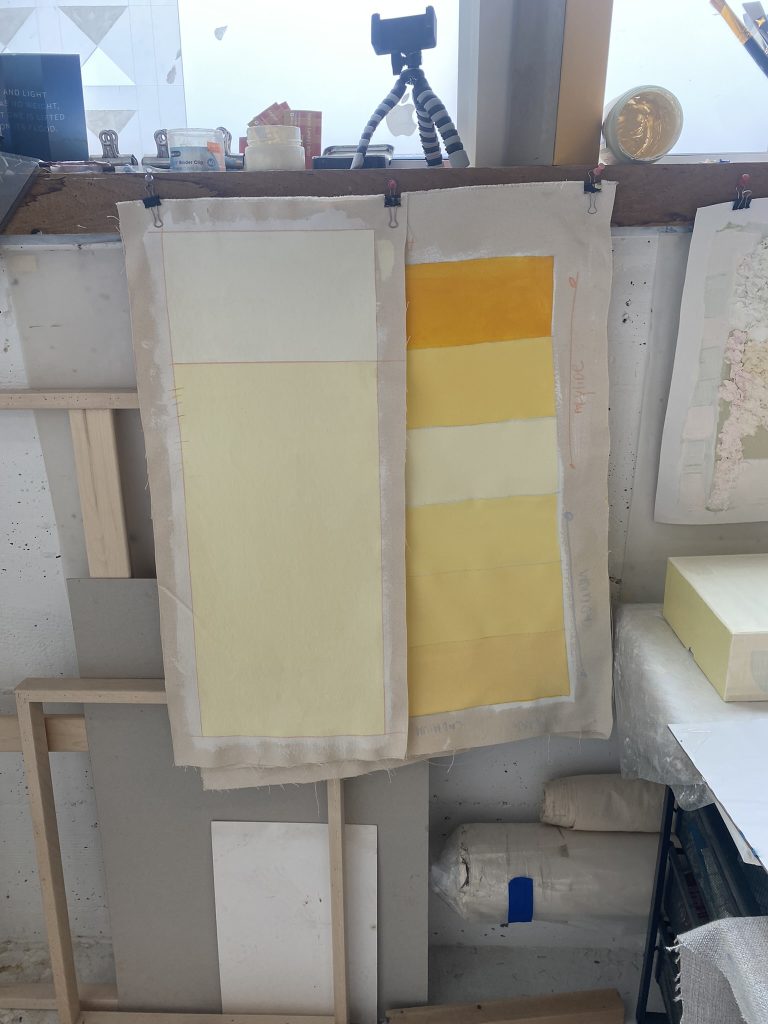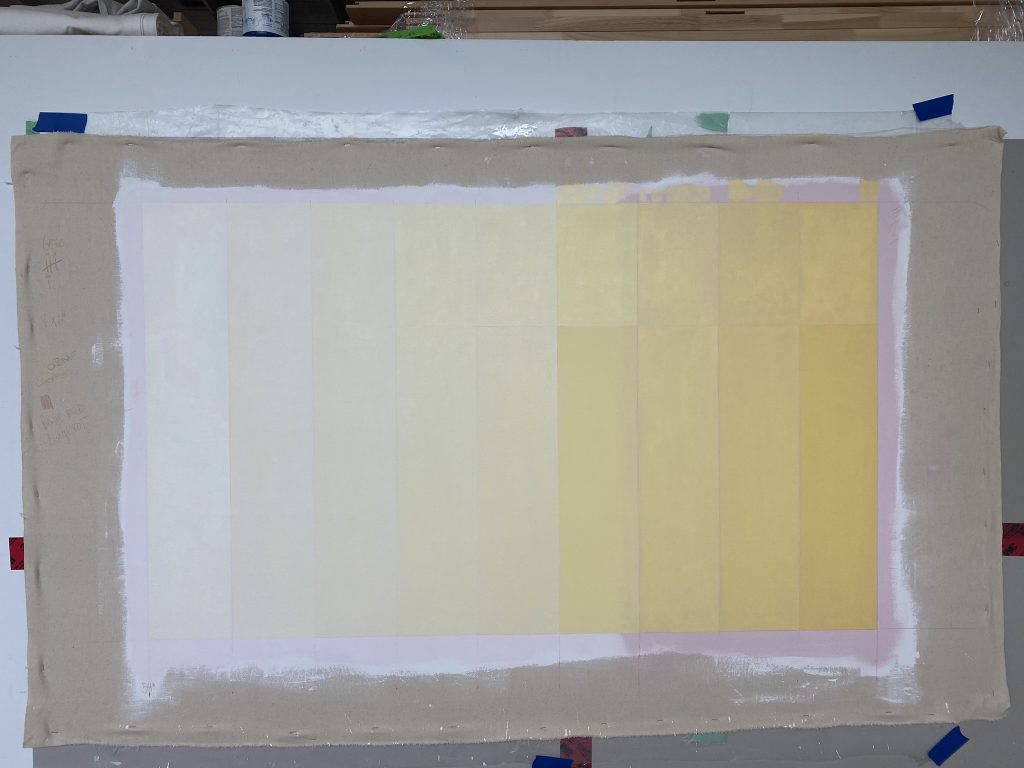9 Elements, 2022
175 x 275cm, acrylic on canvas
A gradient of primerose yellow composed of 9 bands of colour
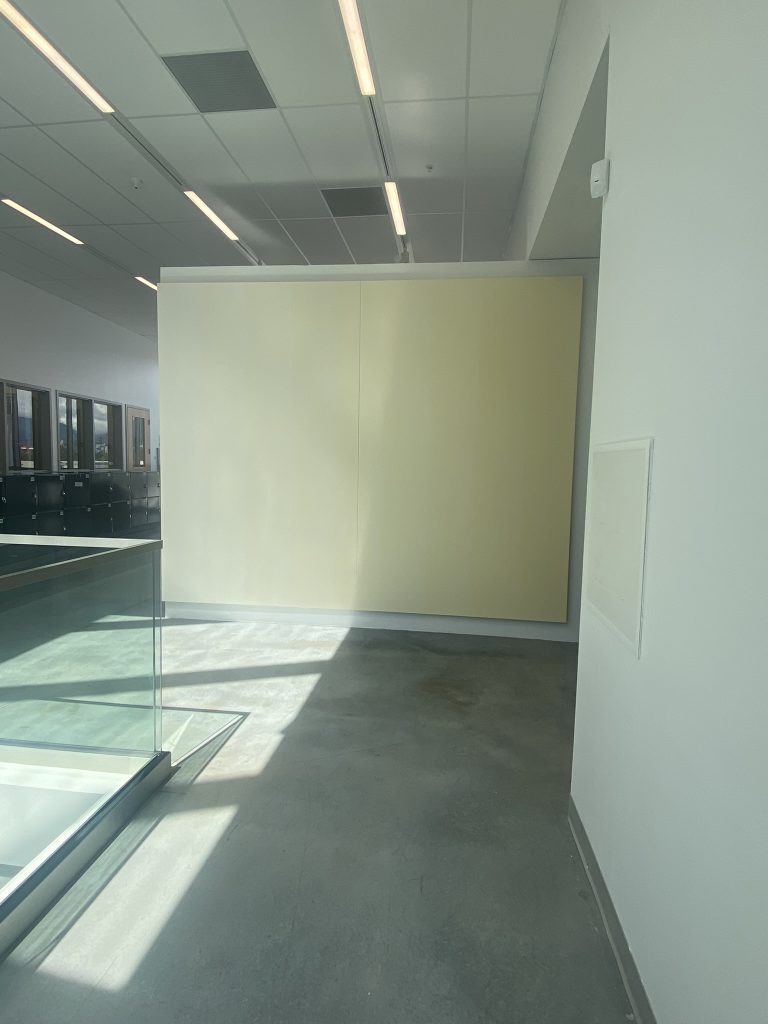
What looks like a simple and minimal painting actually took a lot of material research and studies. Here are some of my comments/feedback.
The painting test started in early May, 2022. I had not painted with acrylic in a really long time and fell out of practice and lacking techniques. May was really overcast in Vancouver and it impacted my perception of colours making me crave a higher contrast for the colour gradient. After the first series of tests, I travelled to Greece for 3 weeks which altered my perception and veered my decision towards a much more subdue gradient. You can see the difference in the study images below.

Gradient test in May, Vancouver 
Gradient test in July, after Greece
Stretchers and stretched
This painting is very large and because I am painting it in school, it has to be painted on a stretcher so I can move it around. This differs completely from my usual technique of painting with a canvas stretched directly to the wall. The wall provides a hard surface for me to trace the grid needed for my geometrical shapes. I also prefer a hard surface to paint as opposed to a stretched canvas which I found too bouncy and distracting. Painting on a stretched canvas comes with many different challenges that I will need to figure out as I go. Due to the size of the painting, I had to settled for two canvases which I ordered from Canada Upper Stretcher. They also suggested that I requests the long size to be collapsible build in two parts held by screws. This would also help with shipping cost. I have never done that either and I feel a bit nervous about it.

Acrylic colour tests – early May, 2022
I visited Kroma Acrylic paints on Granville Island to test some of their acrylic colours. You have to remember that I have not work with acrylics for many years and that I will have to adapt my technique. The paint qualities that I am after are the following: Transparency, matte finish and, the proper viscosity that will allow me to paint vertical without running.
Action #1 – colour
I am first testing different yellow to figure out which one is closest to what I am after. At first I was sure that Cadmium Yellow would do but upon mixing it with titanium white, it appears to have a green tint which I don’t like. By chance I purchased another type of yellow called Azylide Yellow and that is exactly the colour I am after. What I am after is a yellow that is warm and leaning towards orange. Azylide reminds me of organic egg yoke which is perfect.
Action #2 – matte/glossy
At the store, I was suggested to mix a diatomaceous earth powder with my paint to achieved a level of matteness. I am not sure of the ratio so I start by mixing a lot of it in and the paint is drying too matte and too thick. So I slowly reduced the amount until I am happy with it. With the new found ratio, the paint stays transparent and dry totally matte.

Material samples hanging in Senior Painting Studio, July 2022
Action #3 – line colour
To draw the lines that will divide the canvas into 9 bands, I need to use a colour pencil. I have purchase a range of colours and to my surprise, the colours I assumed the best where far from it. The final colour is picked in July when the final test is ready and it is a simple beige.
Acion #4 – The gesso colour/undercoat
I want to have a pale yellow undercoat. This will add a pink glow to the final composition, a phenomena that is perceivable in light quality of Greece. At first I mixed a Cadmium Red with matte medium to paint a light film of red that would read as pink against the white gesso. I found that the matte medium sealed the canvas too much and didn’t like the plastic feel of it. I am now testing mixing the Cadmium red to the gesso and I am satisfied with the result. In the end, the pink is almost not perceivable to the eye but stand out once I start painting the yellow next to it.
Action #5 – The gradient
Now how do I mix all these colours and achieve the gradient I am after? At first I am thinking that mixing the more saturated yellow moving toward a brighter yellow is the way to go. But after 3 bands painted, I don’t like the effect and feels it is too saturated for what I am after. I change the order of things and mix the lightest yellow first moving towards the more saturated. This is the part I am the most nervous about and will need to take my time mixing. I am also realizing that purchasing a kitchen scale will help me with the measurements to insure consistency of matteness and viscosity throughout the process. The paint appears to be keeping better in glass jars as opposed to plastic containers.
Action #6 – Testing the method
Now that I have a better idea about the necessary steps, I need to go through with it and create a small version of the gradient and really hash out the method. I am still clarifying a few steps but will give another chance and try to let go of the anxiety around it. The more I do it, the more I know, the more I know, the more confident I feel. This is a challenging process technically speaking. Many more details need to align but I feel a bit closer now.
Final tests before going to Greece on Friday May 4th. “May the 4th be with you!”
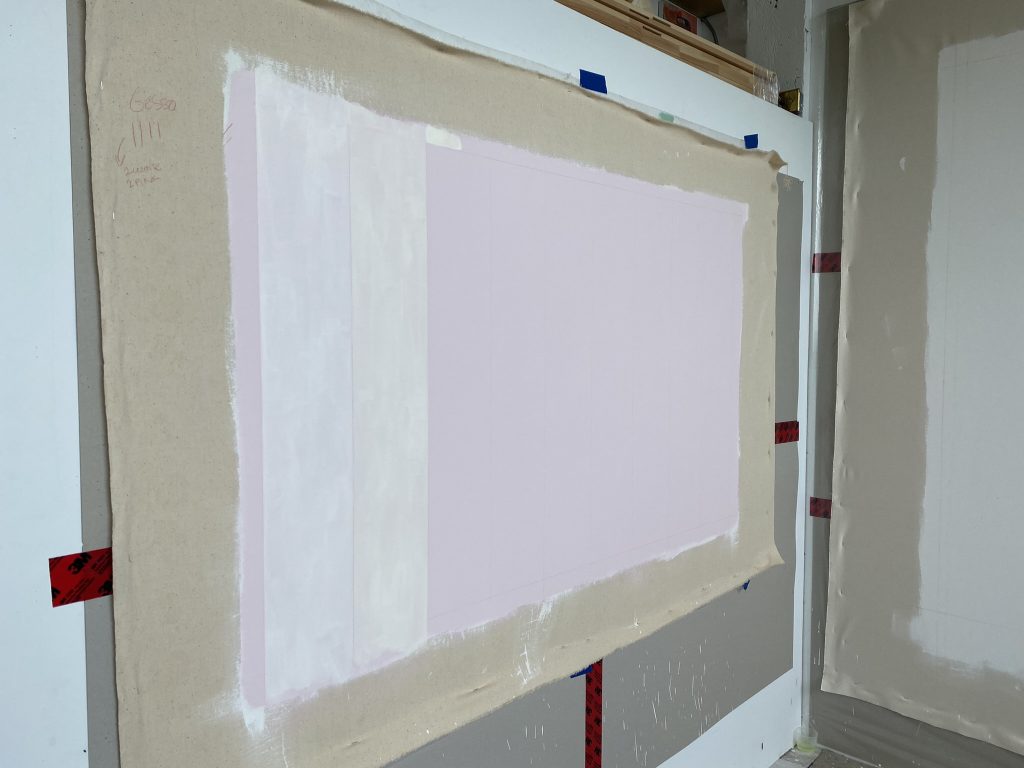
First two bands of light yellow 
Close up- first two bands 
4 bands 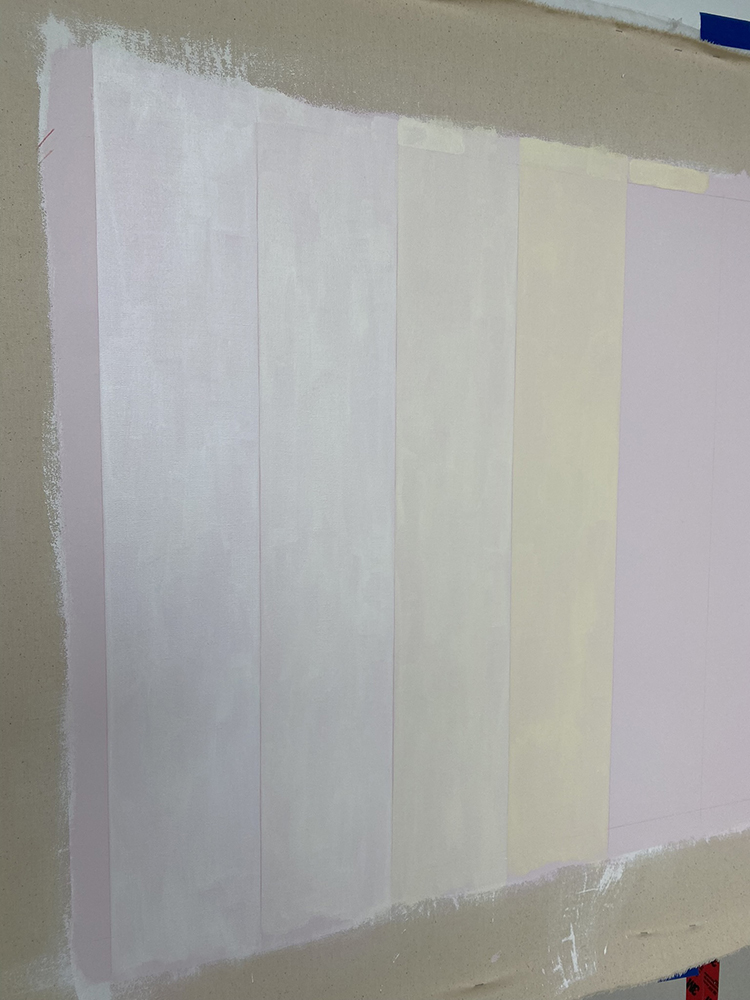
closer look to 4 bands 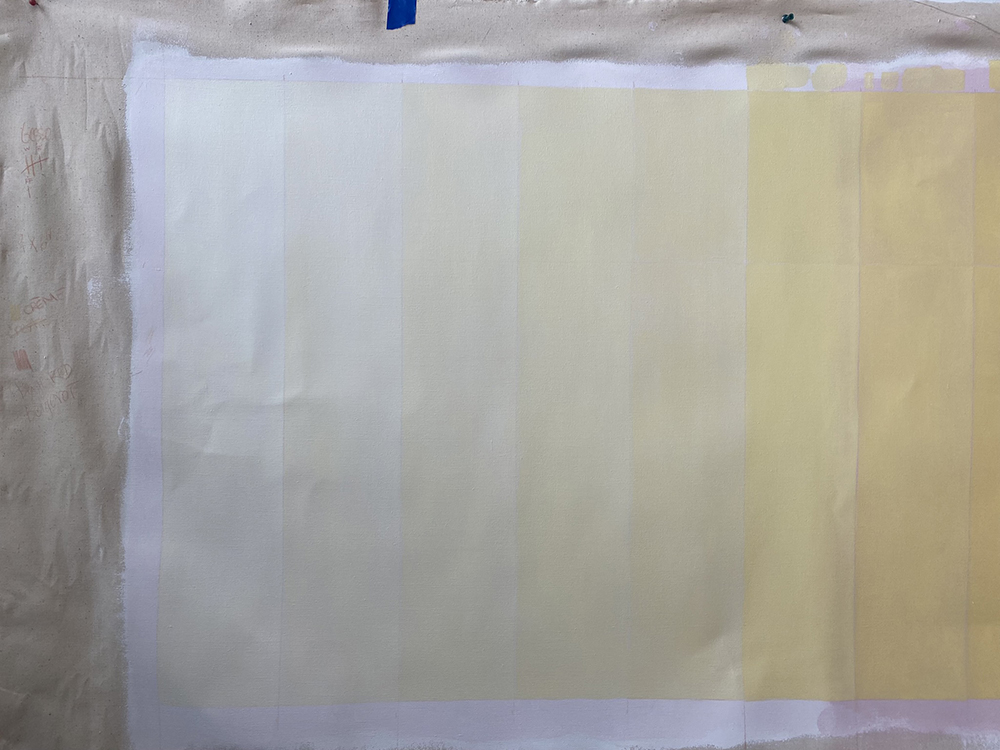
7 bands 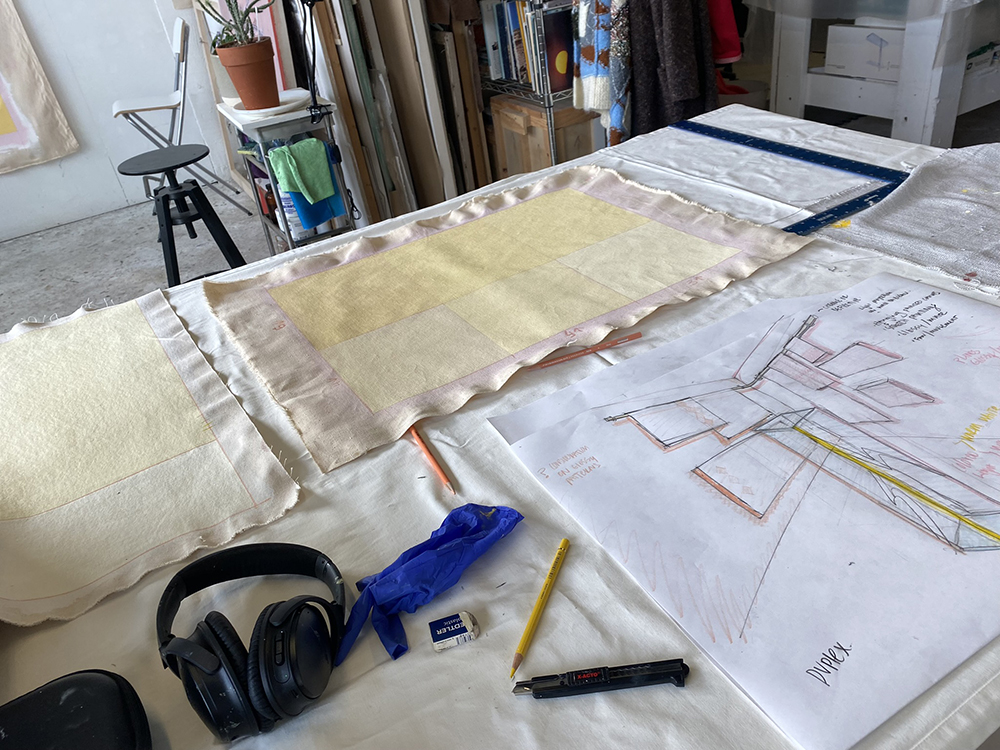
side notes and smaller colour test 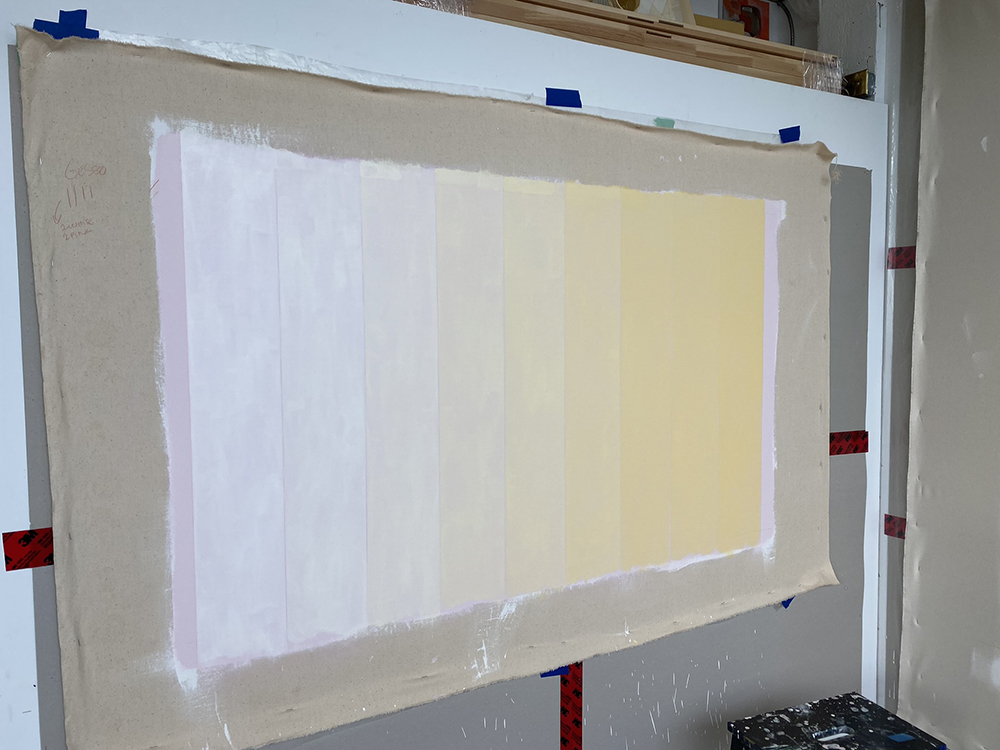
all 9 bands 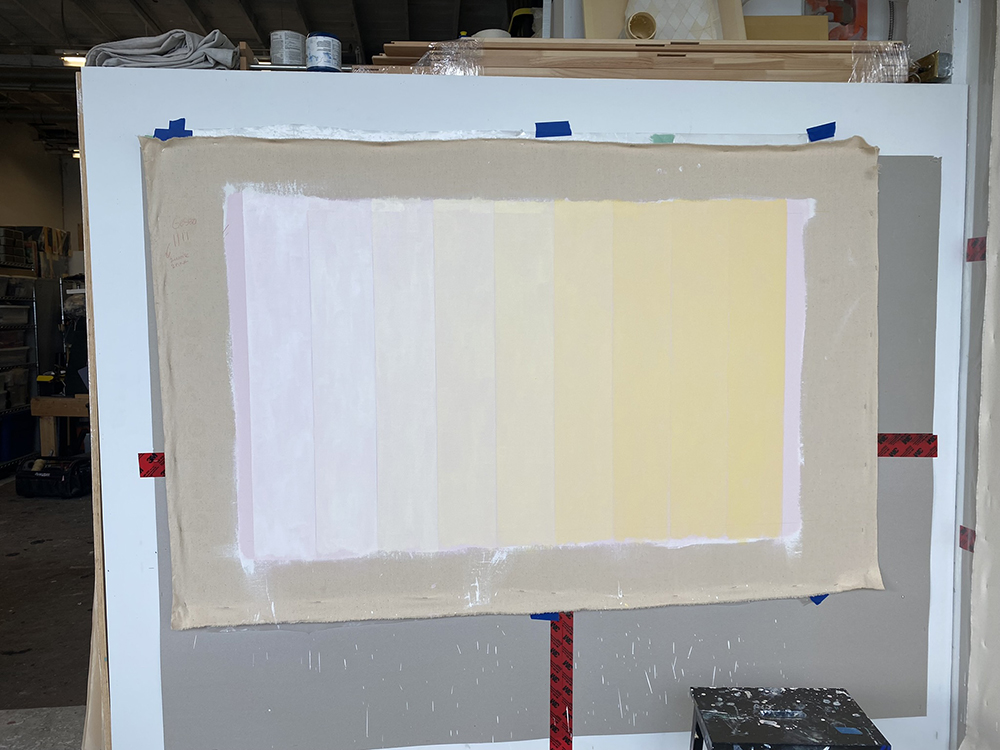
9 bands 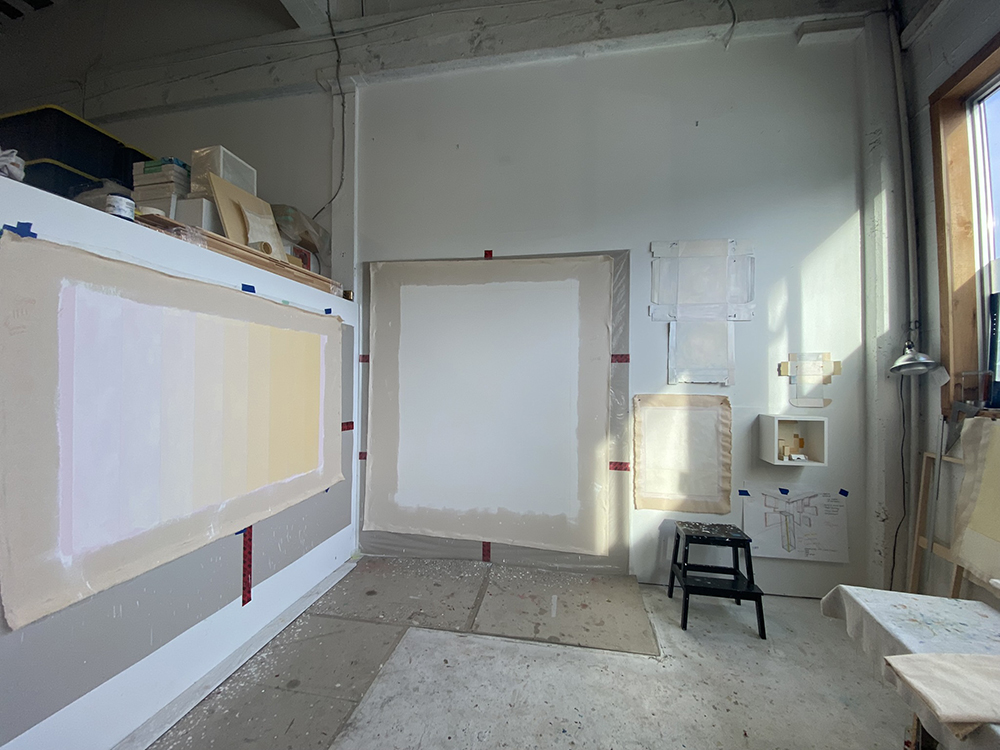
Industrial street studio view May 4th, 2022
Senior Painting Studio, ECU, June 15 to End of July – Welcome to blue light
At first I was allocated the area between B4160 and the painting studio. This is great because it has a similar lighting quality as the wall where the painting will be install. I am really excited about it until I received an email a few days before the beginning of the project to inform me that I have been moved to the Painting Studio B4275. The studio has a lot of good quality: It’s quiet, it’s big enough for the project, it has a lot of window including one that opens. However, because of it being located on the north side, it offers a really blue natural tint. This is not great and will add a challenge to mixing and viewing colours. Oh well, I have to do with it.
Surprise, the evening light bring yellow tones to the Senior Painting Studio
Being a morning person, I am normally in the studio from 9am to about 5pm. With some windows on the east side, the sunshine enters the studio for a few hours in the morning before turning south and provide indirect blue light to the studio for the remaining of the day. One evening, I happened to be on campus late and upon checking the studio, I realized that the evening sunlight was also entering the studio completely changing the ambiance and light spectrum. Magical. I documented to remember the visual and psychological impact.

Evening light in Senior Painting Studio, ECU, 8:30pm, July 2022 
Evening light in Senior Painting Studio, ECU, 8:30pm, July 2022 
Evening light in Senior Painting Studio, ECU, 8:30pm, July 2022 
Evening light in Senior Painting Studio, ECU, 8:30pm, July 2022 
Senior Painting Studio, ECU, daytime light spectrum 
Senior Painting Studio, ECU, daytime light spectrum 
Senior Painting Studio, ECU, daytime light spectrum
How many coats of gesso?
It was suggested to me to start with at least 3-5 coats of gesso with a light sand in between. This should provide a smoother surfaces increasing the vaporous effect of the subdued colour gradient. I am willing to try it. Thankfully I had help at the beginning as this process is physically taxing. Me and Kalvin Valko painted the first coat of gesso and Colin helped me with sanding and painting two more coats. By the third coat I feel happy with the smoothness but upon moving the canvas into my studio, I realized that I need another coat as the surface still appears uneven. In total, 4 coats will be applied with a light sand between each coat and at the end. Having done 2 coats and 2 sanding myself, I am off to the chiropractor, my body is feeling the physical impact. Moving forward, I make sure that I remind myself of working with an assistant for that size of painting.

Colin painting the second coat of gesso – Grad Gallery, July 2022
Studies and more studies – moving towards the light.
I need to be completely confident about the colour tests before I can paint to the large canvas. I make many test and keep moving them around the campus to see them in proper lighting. The studio is so blue that my perception of the yellow band is affected. In the end, I painted a colour swatch for each band and installed them in the Outer Knee Gallery wall to confirm everything. The 4 coats of gesso sanded to test the smoothness, the pink undertone adjusted, the proper level of mattness achieved with the ratio of diatomaceous earth, the vaporous effect once the band is painted thinly, the pencil colour between each band and the overall feel. I look at it for a few days.
The pink glow – an odd to Greece light spectrum
When I installed Configuration #85 in the sculpture gallery, I was completely mesmerized by the pink glow that emanated from some of the boxes that had a top pink edge painted. This pink glow is a phenomena that I observed a lot in Greece where the sun is so warm that white object appears to be glowing pink at times. So I decided to paint the top edge of my canvas pink. This will never be visible to the eye but will be a nice “clin d’oeil” gratifying those who spend time observing the piece and the effect in it’s environment. A light glow will be perceivable on the wall above the painting.


Light spectrum documented in Greece 
Light spectrum documented in Greece 
Light spectrum documented in Greece
3 weeks later, I am ready to paint the large size!
With a final gradient test that I am happy with, and all my colours premixed ready, I feel confident to start painting the large piece. At this point, no more thinking is needed, I can just loose myself in the action of painting.

Painting action
Each band takes about 30 minutes to paint.

Day 1 – Band #1 
Day 1 – Band #2 
Day 1 – Band #3 
Day 1 – Band #4 
Day 1 – Band #4 
Day 2 – Band #5 
Day 2 – Band #5 – first canvas completed 
Day 2 – Band #5 on other canvas 
Day 2 – Band #6 
Day 2 – Band #7- Done for the day 
Day 3 – Band #8, almost done! 
Day 3 – Band #9, done! 
Day 3 – Band #9, second canvas completed.
French cleat and first install – Outer Knee Gallery – ECU
Yang helps me figure out the french cleat system and together we are able to move this monster on it’s final destination, the Outer Knee Gallery wall. It is not the ideal sun at the moment as this piece was envisioned to be in conversation with winter sun, but it gives me an idea of the final result in its environment. I need to get in contact with facility to close of the ceiling light, they are driving me crazy! I also need to figure out the angles that will be used to document the passage of light onto the painting for next February. The painting was install for 4 days which gave me enough time to figure out a few more things and get comments/feedback from a few mentors. Done for now until January-February 2023 where the sun will align itself and provide the lighting phenomena that I am after.
